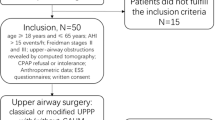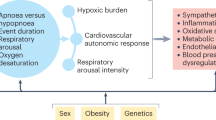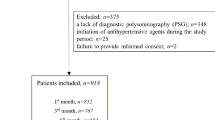Abstract
Background:
Elevated levels of intercellular adhesion molecule 1 (ICAM-1) and vascular cell adhesion molecule 1 (VCAM-1) may contribute to cardiovascular disease and are associated with obstructive sleep apnea (OSA) and obesity. The relationship between OSA and obesity in determining ICAM-1 and VCAM-1 levels, and the effect of treatment, is unclear.
Objective:
Our aim was to study whether positive airway pressure (PAP) usage resulted in changes in ICAM-1 and VCAM-1 after 2 years within 309 OSA patients from the Icelandic Sleep Apnea Cohort, and determine how obesity affected such changes.
Subjects/Methods:
The mean body mass index (BMI) was 32.4±5.1 kg m−2; subjects had moderate-to-severe OSA (apnea–hypopnea index=45.0±20.2) and 79% were male. There were 177 full PAP users (⩾4 h per night and ⩾20 of last 28 nights), 44 partial (<4 h per night or <20 nights) and 88 nonusers.
Results:
ICAM-1 (P<0.001) and VCAM-1 (P=0.012) change was significantly different among the PAP groups. The largest ICAM-1 differences were among the most obese subjects (P<0.001). At follow-up, nonusers had increased ICAM-1 compared with decreased levels in full users. All groups had increased VCAM-1, but nonusers had a significantly larger increase than full users.
Conclusions:
Within moderate-to-severe OSA patients, PAP usage prevents increases in adhesion molecules observed in nonusers after 2 years. For ICAM-1, the largest effect is in the most obese subjects. As OSA and obesity commonly coexist, the usage of PAP to limit increases in adhesion molecules may decrease the rate of progression of OSA-related cardiovascular disease.
This is a preview of subscription content, access via your institution
Access options
Subscribe to this journal
Receive 12 print issues and online access
$259.00 per year
only $21.58 per issue
Buy this article
- Purchase on Springer Link
- Instant access to full article PDF
Prices may be subject to local taxes which are calculated during checkout


Similar content being viewed by others
References
Peppard PE, Young T, Barnet JH, Palta M, Hagen EW, Hla KM . Increased prevalence of sleep-disordered breathing in adults. Am J Epidemiol 2013; 177: 1006–1014.
Pack AI, Gislason T . Obstructive sleep apnea and cardiovascular disease: a perspective and future directions. Prog Cardiovasc Dis 2009; 51: 434–451.
Arnardottir ES, Mackiewicz M, Gislason T, Teff KL, Pack AI . Molecular signatures of obstructive sleep apnea in adults: a review and perspective. Sleep 2009; 32: 447–470.
Ballantyne CM, Entman ML . Soluble adhesion molecules and the search for biomarkers for atherosclerosis. Circulation 2002; 106: 766–767.
Chin K, Nakamura T, Shimizu K, Mishima M, Nakamura T, Miyasaka M et al. Effects of nasal continuous positive airway pressure on soluble cell adhesion molecules in patients with obstructive sleep apnea syndrome. Am J Med 2000; 109: 562–567.
El-Solh AA, Mador MJ, Sikka P, Dhillon RS, Amsterdam D, Grant BJ . Adhesion molecules in patients with coronary artery disease and moderate-to-severe obstructive sleep apnea. Chest 2002; 121: 1541–1547.
Ohga E, Nagase T, Tomita T, Teramoto S, Matsuse T, Katayama H et al. Increased levels of circulating ICAM-1, VCAM-1, and L-selectin in obstructive sleep apnea syndrome. J Appl Physiol 1999; 87: 10–14.
Ohga E, Tomita T, Wada H, Yamamoto H, Nagase T, Ouchi Y . Effects of obstructive sleep apnea on circulating ICAM-1, IL-8, and MCP-1. J Appl Physiol 2003; 94: 179–184.
Ursavas A, Karadag M, Rodoplu E, Yilmaztepe A, Oral HB, Gozu RO . Circulating ICAM-1 and VCAM-1 levels in patients with obstructive sleep apnea syndrome. Respiration 2007; 74: 525–532.
Zamarron C, Riveiro A, Gude F . Circulating levels of vascular endothelial markers in obstructive sleep apnoea syndrome. Effects of nasal continuous positive airway pressure. Arch Med Sci 2011; 7: 1023–1028.
Zamarron-Sanz C, Ricoy-Galbaldon J, Gude-Sampedro F, Riveiro-Riveiro A . Plasma levels of vascular endothelial markers in obstructive sleep apnea. Arch Med Res 2006; 37: 552–555.
Young T, Palta M, Dempsey J, Skatrud J, Weber S, Badr S . The occurrence of sleep-disordered breathing among middle-aged adults. N E J Med 1993; 328: 1230–1235.
Hajer GR, van Haeften TW, Visseren FL . Adipose tissue dysfunction in obesity, diabetes, and vascular diseases. Eur Heart J 2008; 29: 2959–2971.
Clifton PM, Keogh JB, Foster PR, Noakes M . Effect of weight loss on inflammatory and endothelial markers and FMD using two low-fat diets. Int J Obesity 2005; 29: 1445–1451.
Ferri C, Desideri G, Valenti M, Bellini C, Pasin M, Santucci A et al. Early upregulation of endothelial adhesion molecules in obese hypertensive men. Hypertension 1999; 34: 568–573.
Ito H, Ohshima A, Inoue M, Ohto N, Nakasuga K, Kaji Y et al. Weight reduction decreases soluble cellular adhesion molecules in obese women. Clin Exp Pharmacol Physiol 2002; 29: 399–404.
Keogh JB, Brinkworth GD, Clifton PM . Effects of weight loss on a low-carbohydrate diet on flow-mediated dilatation, adhesion molecules and adiponectin. Br J Nutr 2007; 98: 852–859.
Keogh JB, Brinkworth GD, Noakes M, Belobrajdic DP, Buckley JD, Clifton PM . Effects of weight loss from a very-low-carbohydrate diet on endothelial function and markers of cardiovascular disease risk in subjects with abdominal obesity. Am J Clin Nutr 2008; 87: 567–576.
Konukoglu D, Uzun H, Firtina S, Cigdem Arica P, Kocael A, Taskin M . Plasma adhesion and inflammation markers: asymmetrical dimethyl-L-arginine and secretory phospholipase A2 concentrations before and after laparoscopic gastric banding in morbidly obese patients. Obes Surg 2007; 17: 672–678.
Leinonen E, Hurt-Camejo E, Wiklund O, Hulten LM, Hiukka A, Taskinen MR . Insulin resistance and adiposity correlate with acute-phase reaction and soluble cell adhesion molecules in type 2 diabetes. Atherosclerosis 2003; 166: 387–394.
Pou KM, Massaro JM, Hoffmann U, Vasan RS, Maurovich-Horvat P, Larson MG et al. Visceral and subcutaneous adipose tissue volumes are cross-sectionally related to markers of inflammation and oxidative stress: the Framingham Heart Study. Circulation 2007; 116: 1234–1241.
Rohde LE, Hennekens CH, Ridker PM . Cross-sectional study of soluble intercellular adhesion molecule-1 and cardiovascular risk factors in apparently healthy men. Arterioscler Thromb Vasc Biol. 1999; 19: 1595–1599.
Targher G, Bonadonna RC, Alberiche M, Zenere MB, Muggeo M, Bonora E . Relation between soluble adhesion molecules and insulin sensitivity in type 2 diabetic individuals: role of adipose tissue. Diabetes care 2001; 24: 1961–1966.
Vazquez LA, Pazos F, Berrazueta JR, Fernandez-Escalante C, Garcia-Unzueta MT, Freijanes J et al. Effects of changes in body weight and insulin resistance on inflammation and endothelial function in morbid obesity after bariatric surgery. J Clin Endocrinol Metab. 2005; 90: 316–322.
Ziccardi P, Nappo F, Giugliano G, Esposito K, Marfella R, Cioffi M et al. Reduction of inflammatory cytokine concentrations and improvement of endothelial functions in obese women after weight loss over one year. Circulation 2002; 105: 804–809.
Pontiroli AE, Pizzocri P, Koprivec D, Vedani P, Marchi M, Arcelloni C et al. Body weight and glucose metabolism have a different effect on circulating levels of ICAM-1, E-selectin, and endothelin-1 in humans. Eur J Endocrinol 2004; 150: 195–200.
Blankenberg S, Barbaux S, Tiret L . Adhesion molecules and atherosclerosis. Atherosclerosis 2003; 170: 191–203.
Blankenberg S, Rupprecht HJ, Bickel C, Peetz D, Hafner G, Tiret L et al. Circulating cell adhesion molecules and death in patients with coronary artery disease. Circulation 2001; 104: 1336–1342.
Jager A, van Hinsbergh VW, Kostense PJ, Emeis JJ, Nijpels G, Dekker JM et al. Increased levels of soluble vascular cell adhesion molecule 1 are associated with risk of cardiovascular mortality in type 2 diabetes: the Hoorn study. Diabetes 2000; 49: 485–491.
Luc G, Arveiler D, Evans A, Amouyel P, Ferrieres J, Bard JM et al. Circulating soluble adhesion molecules ICAM-1 and VCAM-1 and incident coronary heart disease: the PRIME Study. Atherosclerosis 2003; 170: 169–176.
Malik I, Danesh J, Whincup P, Bhatia V, Papacosta O, Walker M et al. Soluble adhesion molecules and prediction of coronary heart disease: a prospective study and meta-analysis. Lancet 2001; 358: 971–976.
Mulvihill NT, Foley JB, Murphy RT, Curtin R, Crean PA, Walsh M . Risk stratification in unstable angina and non-Q wave myocardial infarction using soluble cell adhesion molecules. Heart 2001; 85: 623–627.
Pak VM, Grandner MA, Pack AI . Circulating adhesion molecules in sleep apnea and cardiovascular disease. Sleep Med Rev. 2013; 18: 25–34.
Price DT, Loscalzo J . Cellular adhesion molecules and atherogenesis. Am J Med 1999; 107: 85–97.
Ridker PM, Hennekens CH, Roitman-Johnson B, Stampfer MJ, Allen J . Plasma concentration of soluble intercellular adhesion molecule 1 and risks of future myocardial infarction in apparently healthy men. Lancet 1998; 351: 88–92.
Schmidt C, Hulthe J, Fagerberg B . Baseline ICAM-1 and VCAM-1 are increased in initially healthy middle-aged men who develop cardiovascular disease during 6.6 years of follow-up. Angiology 2009; 60: 108–114.
Shai I, Pischon T, Hu FB, Ascherio A, Rifai N, Rimm EB . Soluble intercellular adhesion molecules, soluble vascular cell adhesion molecules, and risk of coronary heart disease. Obesity (Silver Spring) 2006; 14: 2099–2106.
Stehouwer CD, Gall MA, Twisk JW, Knudsen E, Emeis JJ, Parving HH . Increased urinary albumin excretion, endothelial dysfunction, and chronic low-grade inflammation in type 2 diabetes: progressive, interrelated, and independently associated with risk of death. Diabetes 2002; 51: 1157–1165.
Maislin G, Rubin DB . Design of non-randomized medical device trials based on sub-classification using propensity score quintiles, topic contributed session on medical devices. Proc Joint Stat Meet 2010; 2182–2196.
Lieu TA, Au D, Krishnan JA, Moss M, Selker H, Harabin A et al. Comparative effectiveness research in lung diseases and sleep disorders: recommendations from the National Heart, Lung, and Blood Institute workshop. Am J Respir Crit Care Med 2011; 184: 848–856.
Ahmed A, Husain A, Love TE, Gambassi G, Dell'Italia LJ, Francis GS et al. Heart failure, chronic diuretic use, and increase in mortality and hospitalization: an observational study using propensity score methods. Eur Heart J 2006; 27: 1431–1439.
Marin JM, Carrizo SJ, Vicente E, Agusti AG . Long-term cardiovascular outcomes in men with obstructive sleep apnoea-hypopnoea with or without treatment with continuous positive airway pressure: an observational study. Lancet 2005; 365: 1046–1053.
Campos-Rodriguez F, Martinez-Garcia MA, de la Cruz-Moron I, Almeida-Gonzalez C, Catalan-Serra P, Montserrat JM . Cardiovascular mortality in women with obstructive sleep apnea with or without continuous positive airway pressure treatment: a cohort study. Ann Int Med 2012; 156: 115–122.
Keenan BT, Maislin G, Sunwoo BY, Arnardottir ES, Jackson N, Olafsson I et al. Obstructive sleep apnoea treatment and fasting lipids: a comparative effectiveness study. Eur Respir J 2014; 44: 405–414.
Mehra R, Xu F, Babineau DC, Tracy RP, Jenny NS, Patel SR et al. Sleep-disordered breathing and prothrombotic biomarkers: cross-sectional results of the Cleveland Family Study. Am J Respir Crit Care Med 2010; 182: 826–833.
Kuna ST, Reboussin DM, Borradaile KE, Sanders MH, Millman RP, Zammit G et al. Long-term effect of weight loss on obstructive sleep apnea severity in obese patients with type 2 diabetes. Sleep 2013; 36: 641–649.
Peppard PE, Young T, Palta M, Dempsey J, Skatrud J . Longitudinal study of moderate weight change and sleep-disordered breathing. JAMA 2000; 284: 3015–3021.
Acknowledgements
We are grateful to Sigrun Gudmundsdottir, Lovisa Gudmundsdottir, Magdalena Osk Sigurgunnarsdottir, Kristján Andri Kristjánsson, Bethany Staley, Matthew Thorne-Fitzgerald, Robert Hachadoorian, Ted Mifflin and the other staff at the Sleep Centers of Landspitali University Hospital and the University of Pennsylvania who helped assemble and analyze the data. We are grateful to Daniel C. Barrett with help in manuscript preparation. The research was supported by NIH grants: HL072067 for ‘A Family Linkage Study of Obstructive Sleep Apnea’; HL094307 for ‘Endophenotypes of Sleep Apnea and Role of Obesity’; HL07973 for ‘Training in Sleep and Sleep Disorders’; 1K99NR014675-01 ‘Mechanisms of Sleepiness Symptoms in Obstructive Sleep Apnea and Cardiovascular Disease’; the Eimskip Fund of the University of Iceland and the Landspitali University Hospital Research Fund.
Author information
Authors and Affiliations
Corresponding author
Ethics declarations
Competing interests
ESA reports personal consulting fees from Nox Medical outside the scope of the submitted work. AIP is the holder of an endowed chair, funds for which were provided by Respironics.
Additional information
Supplementary Information accompanies this paper on International Journal of Obesity website
Supplementary information
Rights and permissions
About this article
Cite this article
Pak, V., Keenan, B., Jackson, N. et al. Adhesion molecule increases in sleep apnea: beneficial effect of positive airway pressure and moderation by obesity. Int J Obes 39, 472–479 (2015). https://doi.org/10.1038/ijo.2014.123
Received:
Revised:
Accepted:
Published:
Issue Date:
DOI: https://doi.org/10.1038/ijo.2014.123



